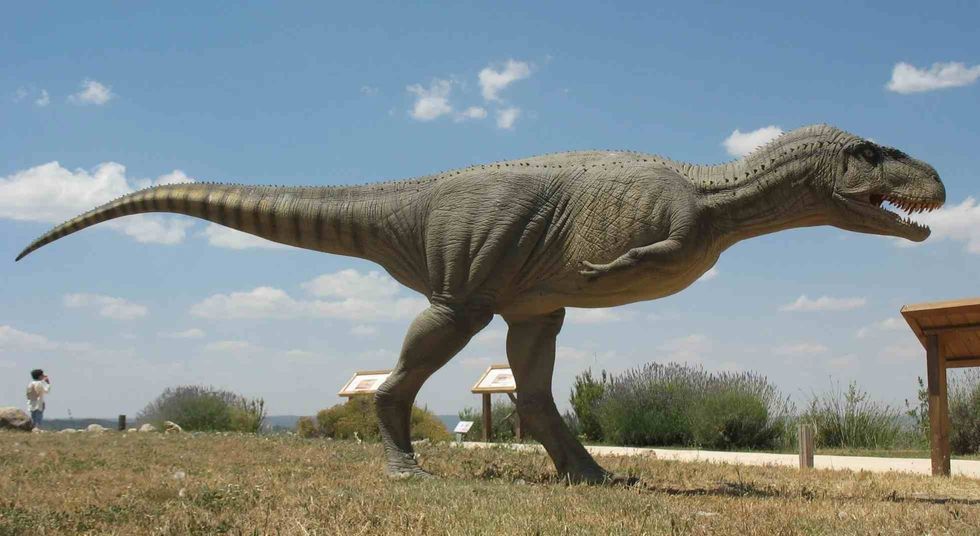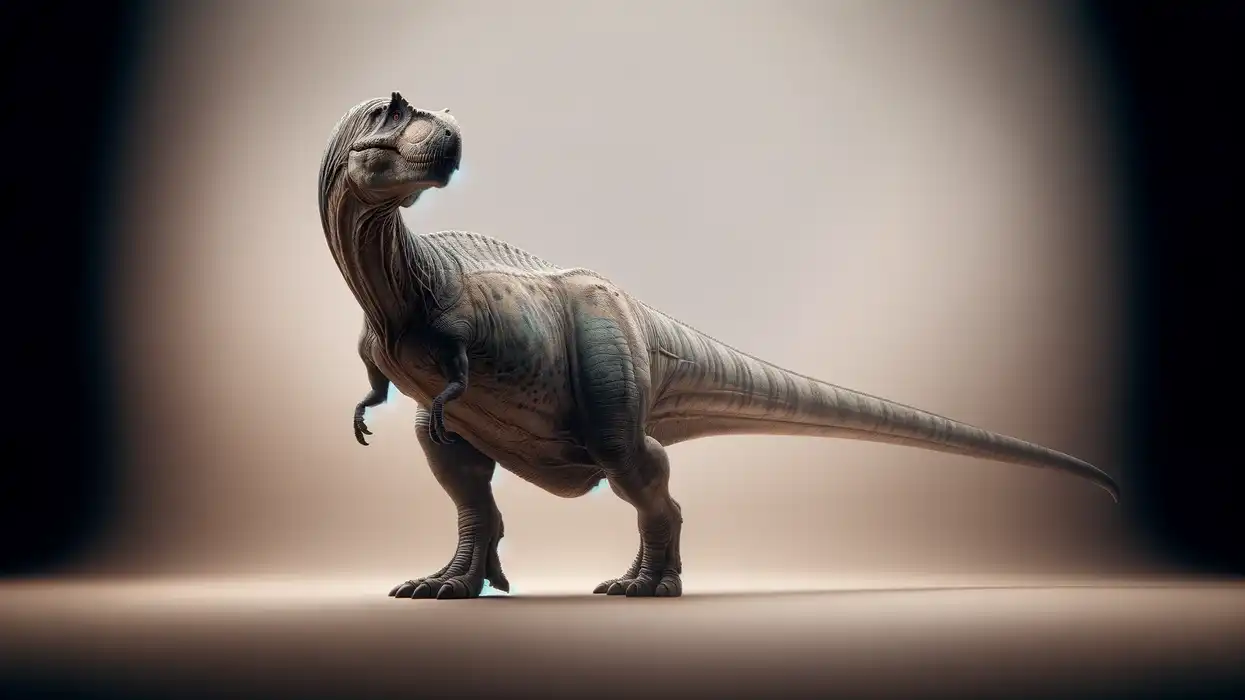Abelisaurus is a genus of bipedal dinosaurs in the family Abelisauridae. It is also called Abel's lizard, a name which was given by Roberto Abel, an Argentinian paleontologist who discovered the type specimen of the A. comahuensis dinosaur.
The scientific name was given by Bonaparte and Novas (1985).
Although the whole dinosaur was rebuilt with fewer remains, the lack of fossil proof had forced paleontologists to make some assumptions about this South American dinosaur. It had holes in its skull, which decreased the weight of its head, which otherwise might have imbalanced its entire body.
Abelisaurus were meat-eating dinosaurs that lived in the temporal range of present-day South America. There is no data reported on whether Abelisaurus had feathers. This dinosaur species is believed to be closely related to theropod dinosaurs from the Jurassic Period.
To learn more about dinosaur species, you can also check out Rahonavis facts and Prosaurolophus facts.
Abelisaurus Interesting Facts
How do you pronounce 'Abelisaurus'?
Abelisaurus is a Greek word for 'Abel's lizard.' It is pronounced 'AY-bell-ih-SORE-us.'
What type of dinosaur was an Abelisaurus?
Abelisaurus (Abel's lizard) is a known dinosaur genus of Abelisaurid theropods that existed during the Late Cretaceous Period. The dinosaur belongs to the phylum Chordata. It was a bipedal dinosaur that was likely to reach a length of about 24.27 ft (7.4 m).
However, the length of the theropod is uncertain because it is known from only an incomplete skull. The one and only species in the genus is Abelisaurus comahuensis. It was named Abel's lizard by Roberto Abel, but the scientific name was given by Novas and Bonaparte.
In which geological period did the Abelisaurus roam the earth?
Abelisaurus lived during the Late Cretaceous Period (85-80 million years ago).
When did the Abelisaurus become extinct?
All the Abelisaurus species of dinosaurs went extinct in the Late Cretaceous, about 85-80 million years ago.
Where did an Abelisaurus live?
Abelisaurus dinosaur species was found in a known area Patagonia in Argentina. Its fossil was found in the Anacleto Formation.
The fossil of the dinosaur was formed in the Late Cretaceous Period about 85-80 million years ago.
The species is believed to be closely related to theropod dinosaurs from the Jurassic Period. Unfortunately, only a single skull of the dinosaur has been found, but its dimensions of the body were probably the same as that of other large theropod dinosaurs with the same size skulls, around 3 ft (91.4 cm) long.
Carnotaurus had thin legs, the front part was shorter than the back part. Since Carnotaurus may be one of the earliest Abeiliosaurus, scientists hypothesized that Abeiliosaurus also had short forelimbs and slender legs.
Other details of the body are anonymous. The discovery of the Abelisaurus dinosaurs is significant because it reveals many different theropods in the southern hemisphere, which can only be known from puzzling fragments.
These remains were illegible and were seldom used to suggest that the Late Cretaceous Tyrannosaurus from the Northern Hemisphere was in the Southern Hemisphere.
Now that great matters of Abelisaurus have been discovered and named, scientists have determined that many of these remains were of Abelisaurus. The chance of Tyrannosaurus from the southern hemisphere is less.
What was an Abelisaurus's habitat?
The habitat of Abelisaurus was mainly among the woodlands of South America.
Who did an Abelisaurus live with?
Whether Abelisaurus dinosaurs lived alone, in pairs or groups is unknown.
How long did an Abelisaurus live?
The lifespan of the Abelisaurus dinosaur has been unknown.
How did they reproduce?
No information is available regarding the reproduction of Abelisaurus dinosaurs.
Abelisaurus Fun Facts
What did an Abelisaurus look like?

Abelisaurus saurinshcia was a bipedal carnivore and probably reached approximately 30 ft (9.14 m) in length. However, this is doubtful because it is only known from a partial skull.
Only the skull of the dinosaur is known, so it has been difficult to provide a reliable estimate of the size of Abelisaurus. The head of Abelisaurus has been confirmed to be relatively short.
In 2010, Gregory S. Paul estimated that its body was 32.80 ft (10 m) long and weight was 2 tons (1814.37 kg).
Later, in 2012, Thomas Holtz gave a plausible length of 36.3 ft (11.06 m). After that, in 2016, in a comprehensive analysis of the size of the Abelisaur, its length was estimated to be 24.27 ft (7.4 m) and weight about 1.65 tons (1496.85 kg).
In 1985, the Abelisaurus skull length estimated to be was 33.46 in (85 cm). It is relatively deep.
Unlike other Abelisaurids in comparison, no bony crests or horns were found of Abelisaurus. For instance, there are irregular ridges on the snout and above the eyes in the fossil of Carnotaurus. The skull roof of the Abelisaurus dinosaur is thickened.
Various large fenestrae are also present on it right above the jaws, which resulted in the reduction of the skull weight. Scientists believe that this could be an Abelisaurus evolution technique.
The large triangular fenestra is present on the snout behind which the eye socket was rather high. It is compressed in the central by bony ridges of the lacrimal bone in the front and the postorbital bone at the back. The anterior nasal bone, the upper jaw, has four relatively small teeth.
There are at least seven to thirteen larger teeth behind the maxilla. Abelisaurus comahuensis, the largest theropod, was similar to the Albertosaurus dinosaur of Alberta (Canada), particularly in its size and lifestyle.
How many bones did an Abelisaurus have?
Since only the skull from the entire Abelisaurus skeleton has been found, the exact number of bones in the dinosaur is unknown.
How did they communicate?
No information about the communication in the Abelisaurus is known.
How big was an Abelisaurus?
The Abelisaurus size range has been estimated to be around 30 ft (9.14 m). If Abelisaurus size comparison is made with animals existing today, they were 50 times larger than Indus river dolphins.
How fast could an Abelisaurus move?
The running speed of the Abelisaurus dinosaur is unknown.
How much did an Abelisaurus weigh?
The Abelisaurus scale would have weighed around 2 tons (1814.37 kg), which is 20 times bigger and heavier than Masai giraffe.
What were the male and female names of the species?
No sex-specific names were given to male and female Abelisaurus.
What would you call a baby Abelisaurus?
The Abelisaurus baby would have been called young.
What did they eat?
Abelisaurus were meat-eating dinosaurs. It is believed that, as an animal similar to Tyrannosaurus, such as Tyrannosaurus Rex, Abelisaurus was a top predator means it was at the top of the food chain and had no predators.
Gregory S. Paul, a dinosaur expert, believes that these carnivore animals preyed on Titanosaurus, which were massive dinosaurs with elongated necks and tails and could walk on all four legs. They were sauropods dinosaurs, which included giants such as Diplodocus and Apatosaurus.
How aggressive were they?
Abelisaurus dinosaurs, named Abel's lizard by Roberto Abel, would have been very aggressive carnivores like tigers in the current animal context, as they were on the top of the food chain in the Late Cretaceous period.
Did you know...
During the Cretaceous period, Abelisaurus lived as a whole on the mainland of Gondwana Island. Today, the region actually includes temporal places of South America, Madagascar, and Africa.
How did the Abelisaurus get its name?
Both Abelisaurus genus and the type species Abelisaurus comahuensis were named by two paleontologists José Bonaparte and Fernando Emilio Novas (1985). The generic name was given after an Argentinian paleontologist Roberto Abel, the discoverer of the specimen and the prior director of the provincial Science Museum of Cipolletti in Argentina.
The name also includes the Greek term sauros, meaning 'lizard'. The specific name comahuensis recognizes the Comahue area of Argentina, where the fossil of the dinosaur was found.
What did the Abelisaurus use its arms for?
Although the arms of Abelisaurus comahuensis and other large members of the family Abelisauridae were small, they were strong and muscular, suggesting that dinosaurs might use their arms as meat hooks when entangled with prey.
Here at Kidadl, we have carefully created lots of interesting family-friendly dinosaur facts for everyone to discover! Learn more about some other dinosaurs from our Tupuxuara facts and Brachytrachelopan facts pages.
You can even occupy yourself at home by coloring in one of our free printable d is for dinosaur coloring pages.









